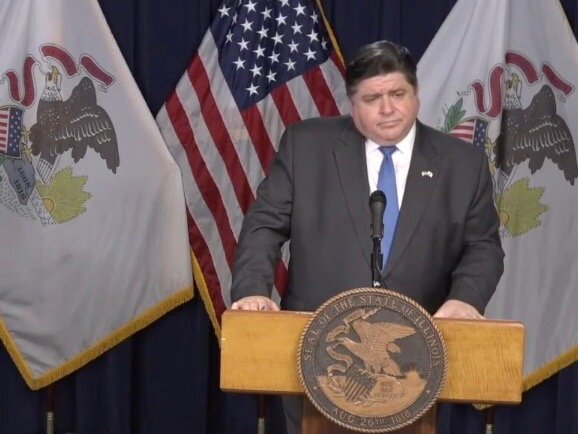New single-day high for COVID-19 cases
Governor lays out plans for contact tracing, insists protesters won’t dictate end of stay-at-home order
Gov. Pritzker defended protesters’ right to free speech, “even when they’re wrong,” in maintaining the statewide stay-at-home order Friday. (Illinois.gov)
By Ted Cox
As hundreds protested both against and in favor of the COVID-19 stay-at-home order outside the Thompson Center Friday in Chicago, the state reported a new single-day high with 3,137 new cases of the coronavirus.
“We have bent the curve. It’s not an accident,” Gov. Pritzker said at his daily coronavirus briefing. “And it’s not like this virus has gone away either. It’s because people are adhering to the norms that we put out there.”
Pritzker maintained that while hundreds protested the order in Chicago and in Springfield, millions of Illinoisans support it and know that it’s working to slow the spread of COVID-19, even as the 3,137 new cases brought the state total to 56,055, and 105 new deaths pushed the statewide toll to 2,457.
In response to those who urged him to ease restrictions where the outbreak is not as severe, Pritzker again pointed to how his new order, which took effect Friday and lasts to May 30, opens state parks and golf courses downstate, while easing restrictions on elective surgeries at hospitals in those areas. He said he was open to ending the order in areas that are “past the peak” of infections and show “14 days on the downslide.” But he emphasized that the state is not yet past that peak and that no area of the state could say that yet with certainty.
“There are a few hundred protesters today, both here and in Springfield,” Pritzker said. “They’re exercising their right to free speech, and I’ll defend to the death their right to exercise that right — even when they’re wrong.
“Listen, I want as much as anybody does for everybody to get back to work and for us to move toward normalcy,” he added. “But I also want to say that I’m not going to do it until I know people are safe, and it isn’t going to be because some protester has a sign that says, ‘Liberate Illinois.’”
The governor also laid out plans for contact tracing, another key element in allowing the state to move forward in reopening the economy and easing restrictions on gatherings. Calling tracing “a primary tool to identify potential asymptomatic spreaders,” Pritzker said Dr. Wayne Duffus of the Centers for Disease Control and Prevention would be leading the state’s tracing initiative.
Duffus said contact tracing had historically been used to monitor outbreaks of tuberculosis and sexually transmitted infections, including HIV.
Pritzker said that, given the pandemic, “The whole world must contact trace on a never-before-seen scale,” adding, “It’s an unprecedented public health challenge, so we need an unprecedented solution to meet this moment.”
Tracers will contact those newly positive for the disease and ask about people they had contact with in previous days. They’ll then contact those people — without identifying the original patient — and warn them to seek a test and self-isolate. They’ll also provide those isolated people with resources, including food, medicine, and potentially an alternate place to live while waiting out the incubation period.
“It is how we break transmission and how we make sure we don’t have a large outbreak,” Duffus said.
Pritzker and Duffus both emphasized the need for privacy in the process, in part to encourage participation. “Looking backward and pointing fingers doesn’t help anyone in this situation,” Pritzker said.
“The actual number of staff needed is large,” Duffus granted. On a ratio of 30 tracers per 100,000 people, Illinois would need 3,810 people to staff it, although that would also allow the “capability to surge as needed.”
Pritzker said it was modeled on a program in place in Massachusetts, at a cost of $40 million. He estimated Illinois would require double that because of its larger population.
The governor and Duffus said the program would be well-suited to former health professionals, fresh graduates, and others with a sense for details and a handle on the technology required. Duffus said it would suit “anyone who’s bright, interested, and has a charming personality.” He added that they expected to launch the program by the end of the month.
Outside the Thompson Center, the protests against the stay-at-home order aped previous protests in Michigan and other states, some prompted by President Trump’s incendiary call to “liberate” those states. But in Chicago protesters were confronted by members of the Illinois Nurses Association with banners reading, “Nurses are dying. Go home.”

